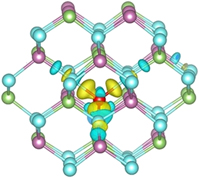Article contents
Dopant–dopant interactions in beryllium doped indium gallium arsenide: An ab initio study
Published online by Cambridge University Press: 14 January 2018
Abstract

We present an ab initio study of dopant–dopant interactions in beryllium-doped InGaAs. We consider defect formation energies of various interstitial and substitutional defects and their combinations. We find that all substitutional–substitutional interactions could be neglected. On the other hand, interactions involving an interstitial defect are significant. Specially, interstitial Be is stabilized by about 0.9/1.0 eV in the presence of one/two BeGa substitutionals. Ga interstitial is also substantially stabilized by Be substitutionals. Two Be interstitials can form a metastable Be–Be–Ga complex with a dissociation energy of 0.26 eV/Be. Therefore, interstitial defects and defect–defect interactions should be considered in accurate models of Be-doped InGaAs. We suggest that In and Ga should be treated as separate atoms and not lumped into a single effective group III element, as has been done before. We identified dopant-centred states which indicate the presence of other charge states at finite temperatures, specifically, the presence of Beint +1 (as opposed to Beint +2 at 0 K).
Keywords
- Type
- Invited Paper
- Information
- Copyright
- Copyright © Materials Research Society 2018
Footnotes
Contributing Editor: Susan B. Sinnott
References
REFERENCES
- 4
- Cited by



